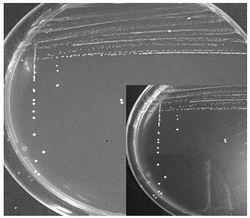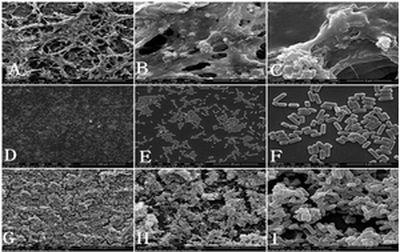A caries-resistant Lactobacillus plantarum and its application
A technology for Lactobacillus plantarum and caries, applied in the field of microorganisms, can solve problems such as staying, and achieve the effects of good survival ability, good inhibitory effect, good self-aggregation and copolymerization ability
- Summary
- Abstract
- Description
- Claims
- Application Information
AI Technical Summary
Problems solved by technology
Method used
Image
Examples
Embodiment 1
[0031] Example 1 Isolation, screening and molecular biology identification of Lactobacillus plantarum K41
[0032] 1. Material preparation
[0033] The samples were collected from homemade kimchi at a farmhouse on Yan'an Road, Shunqing District, Nanchong City, Sichuan Province;
[0034] The universal primer pair was synthesized by Invitrogen (Shanghai), and the 27F / 1492R sequence is as follows:
[0035] 27F: AGAGTTTGATCMTGGCTCAG
[0036] 1492R: TACGGYTACCTTGTTACGACTT
[0037] PBS buffer solution: Potassium dihydrogen phosphate 0.20g, disodium hydrogen phosphate 1.15g, sodium chloride 8.0g, potassium chloride 0.2g, add 800mL pure water and stir to dissolve, adjust concentrated hydrochloric acid to the corresponding pH value, and dilute to 1L.
[0038] 2. Isolation and screening of plant lactic acid bacteria with inhibitory effect on Streptococcus mutans and their molecular biological identification
[0039] Cut the collected sample into pieces, weigh 1 g, and put it into 9 ...
Embodiment 2
[0045] Example 2 Aggregation ability test of Lactobacillus plantarum K41
[0046] 1) Self-aggregation test: K41 and UA159 were cultured overnight at 37°C, centrifuged at 8000r / min for 10min, and the supernatant was discarded to collect the bacteria. Wash the bacteria twice with PBS buffer (same as Example 1) and resuspend, adjust the absorbance value OD of the bacteria suspension 600 0.6±0.02 (A 0 ). Take 2mL of the bacterial suspension and culture it at room temperature, and measure the OD of the supernatant every 1h 600 (At), a total of 4h was measured, with 3 repetitions in each group.
[0047] Self-aggregation ability = (A 0 -At) / A 0 ×100%
[0048] 2) Co-aggregation test: the preparation method of Streptococcus mutans and lactic acid bacteria suspension is the same as the self-aggregation ability test. Take 1 mL of lactic acid bacteria suspension (Ax) and 1 mL of Streptococcus 1h Measure the OD of the supernatant 600 (A(x+y)), measured for 4 hours in total, with 3 ...
Embodiment 3
[0053] Example 3 Lactobacillus plantarum K41 inhibits exopolysaccharide test
[0054] Adjust the suspension of UA159 and K41 bacteria activated for three generations to OD 600 =1±0.02, inoculate UA159 with 2% inoculation amount in BHI liquid medium containing 2% (w / v) sucrose, add an equal volume of K41 bacterial suspension and mix well, and use MRS medium without bacterial liquid as blank For the control, cultured at 37°C for 24 hours, and each group had 3 replicates. Anthrone-sulfuric acid method was used to measure the content of exopolysaccharide, glucose was used as a standard curve, and then the content of exopolysaccharide was calculated from the standard curve.
[0055] The test results showed that: Lactobacillus plantarum K41 could significantly inhibit the formation of Streptococcus mutans exopolysaccharide, the inhibition rate of soluble exopolysaccharide was 44.06%, and the inhibition rate of insoluble exopolysaccharide was 90.70%.
PUM
| Property | Measurement | Unit |
|---|---|---|
| diameter | aaaaa | aaaaa |
| diameter | aaaaa | aaaaa |
| absorbance | aaaaa | aaaaa |
Abstract
Description
Claims
Application Information
 Login to View More
Login to View More - R&D
- Intellectual Property
- Life Sciences
- Materials
- Tech Scout
- Unparalleled Data Quality
- Higher Quality Content
- 60% Fewer Hallucinations
Browse by: Latest US Patents, China's latest patents, Technical Efficacy Thesaurus, Application Domain, Technology Topic, Popular Technical Reports.
© 2025 PatSnap. All rights reserved.Legal|Privacy policy|Modern Slavery Act Transparency Statement|Sitemap|About US| Contact US: help@patsnap.com



